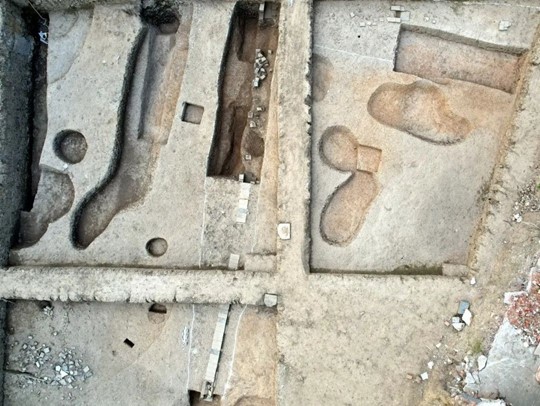New discovery of 156 remains at Jiaopuxiang shows local human activity since pre-Qin times

Architectural foundation sites from the Tang Dynasty and Five Dynasties period discovered at the Jiaopuxiang site in Changzhou, East China's Jiangsu Province. (Photo/Courtesy of Changzhou Institute of Archaeology)
Chinese archaeologists have uncovered 156 new remains and more than 500 precious artifacts at the Jiaopuxiang site in Changzhou, East China's Jiangsu Province, providing evidence that humans have been active in the area since the pre-Qin period, China Culture Daily reported on Saturday.
The Jiaopuxiang site is located in the Nanda street, Zhonglou district, at the intersection of the Grand Canal and the historic axis of the old city in Changzhou. Excavated across an area of approximately 3,000 square meters, the site is surrounded by other notable heritage landmarks.
Among the 156 unearthed objects, significant finds include roads and ditches from the Six Dynasties period (220-589), tamped-earth city walls and moats, streets and drainage facilities from the Tang Dynasty (618-907) and Five Dynasties (907-960) eras, as well as large Song Dynasty (960-1279) buildings and courtyards. Meanwhile, two Song Dynasty building foundations were also uncovered.
One, located on the east side of the excavation, consists of seven square pillar bases measuring approximately 15.2 meters long and 4 meters wide, and is possibly linked to the historic Liedi Temple ancestral hall. The other is a well-preserved three-courtyard, five-bay structure facing the Grand Canal, measuring about 25 meters east-west and 17.5 meters north-south, with 16 square pillar bases remaining. Researchers believe it may have served as a military drill ground or an official temple complex during the Song Dynasty.
Beyond these discoveries, more than 500 artifacts from the Spring and Autumn period (770BC-476BC) to the Ming (1368-1644) and Qing (1644-1911) dynasties were unearthed at the site, including ceramics, pottery, metalwork, lacquerware, bone and horn tools, and stone implements.
Although no cultural layers or structures from the Spring and Autumn period were found, stone adzes and pottery shards at the bottom of some refuse pits indicate human presence as far back as the pre-Qin era.
According to China Culture Daily, the excavation at Jiaopuxiang systematically reveals the historical layers and cultural depth of Changzhou's old city. Additionally, the discovery holds significant value for research into the urban development of cities in the Jiangnan region and the origins of regional civilization in Jiangsu.
According to historical records, Changzhou was fortified on a large scale during the late Tang and Five Dynasties period with three layers of walls, the "inner city," "outer city," and "outermost wall." The newly uncovered wall segment between the outer city and the outermost wall, closely aligned with the course of the Grand Canal, not only revises the known history of Changzhou's urban defenses but also provides new material for the study of ancient city walls and fortification techniques.
